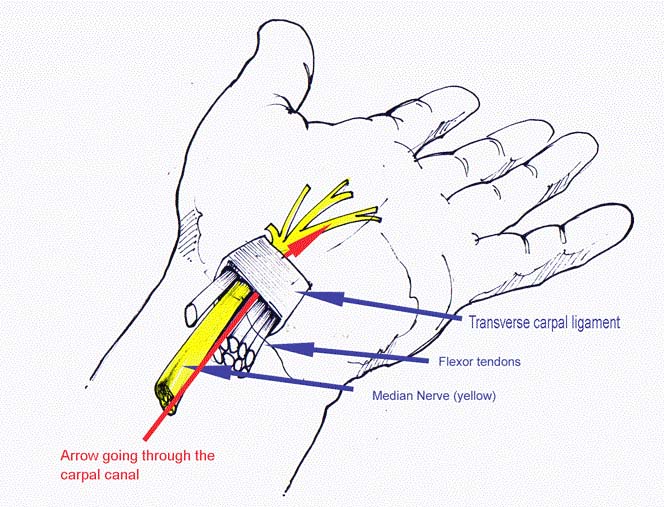Carpal tunnel syndrome
What is it?
Carpal tunnel syndrome (CTS) is a condition where the median nerve is compressed where it passes through a short tunnel at the wrist. The tunnel contains the tendons that bend the fingers and thumb as well as the nerve (see diagram). CTS commonly affects women in middle age but can occur at any age in either sex. CTS can occur with pregnancy, diabetes, thyroid problems, rheumatoid arthritis and other less common conditions, but most sufferers have none of these. CTS may be associated with swelling in the tunnel which may be caused by inflammation of the tendons, a fracture of the wrist, wrist arthritis and other less common conditions. In most cases, the cause is not identifiable.
What are the symptoms?
The main symptom is altered feeling in the hand, affecting the thumb index, middle and ring fingers; it is unusual for the little finger to be involved. Many people describe the altered feeling as tingling. Tingling is often worse at night or first thing in the morning. It may be provoked by activities that involve gripping an object, for example a cell phone or newspaper, especially if the hand is elevated. In the early stages the symptoms of tingling intermittent and sensation will return to normal. If the condition worsens, the altered feeling may become continuous, with numbness in the fingers and thumb together with weakness and wasting of the muscles at the base of the thumb. Sufferers often described a feeling of clumsiness and drop objects easily. CTS may be associated with pain in the wrist and forearm.
In some cases, nerve conduction tests are needed to confirm the diagnosis. Blood tests and x-rays are sometimes required.
What is the treatment?
Non-surgical treatments include the use of splints, especially at night, and steroid injection into the carpal tunnel. CTS occurring in pregnancy often resolves after the baby is born.
Surgery is frequently required. The operation involves opening the roof of the tunnel to reduce the pressure on the nerve (see diagram: the roof of the carpal tunnel is called the transverse carpal ligament). The most common method involves an incision over the tunnel at the wrist, opening the roof under direct vision. In an alternative keyhole method (endoscopic release) the roof is opened with instruments inserted through one or two small incisions. The outcomes of the two techniques are similar and your surgeon can discuss the most appropriate method. The surgery may be performed under local anesthesia, regional anesthesia (injected at the shoulder to numb the entire arm) or general anesthesia.
The outcome is usually a satisfactory resolution of the symptoms. Night pain and tingling usually disappear within a few days. In severe cases, improvement of constant numbness and muscle weakness may be slow or incomplete. It generally takes about three months to regain full strength and a fully comfortable scar, but the hand can be used for light activities from the day of surgery.
Dr. Bodavula performs both endoscopic and open carpal tunnel surgery .
Main Office - St Charles County 5600 Mexico Rd, Suite 21 St. Peters, MO 63376
DePaul Medical Center 3394 McKelvey Rd, Suite 115 Bridgeton, MO 63044
West County Office 555 N. New Ballas Rd, Suite 175 Creve Coeur, MO 63141
Lincoln County Office 1004 E Cherry St Troy, MO 63379
Telephone:
(636) 373-9882
Fax:
(886) 283-3416
© copyright BSSH 2011
http://endoscopiccarpaltunnestl.homestead.com/
Endoscopic Carpal tunnel release video. You can see that through a small incision in the wrist crease, a camera with a special blade is introduced into the carpal tunnel and the carpal ligament is cut from inside.
This avoids any large skin cuts and results in faster healing and quicker return to activities - Dr. Bodavula
